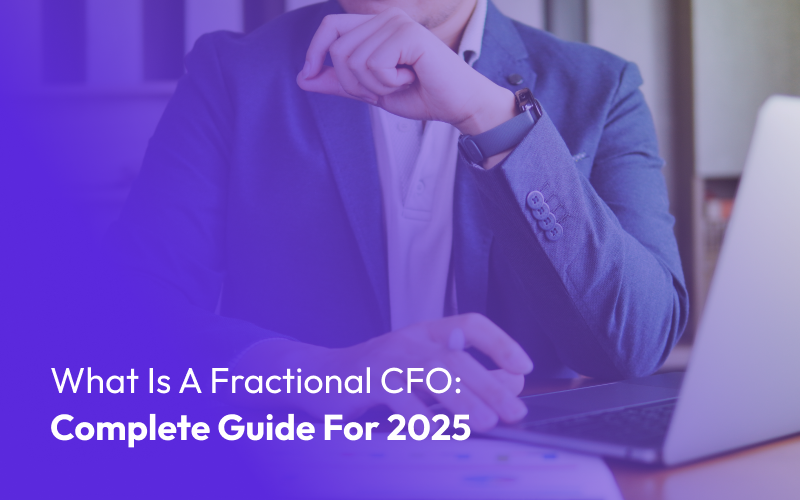Introduction: Moving Beyond the Bookkeeper
For any business that has crossed the initial revenue threshold—typically the seven-figure mark—the complexity of its financial life outpaces the capabilities of a bookkeeper or an outsourced accounting firm. You are no longer just tracking past transactions; you are managing future risk. This is the inflection point where a lack of strategic financial leadership transforms potential growth into dangerous chaos, leading to the common but devastating paradox of strong profitability but weak cash flow.
The Chief Financial Officer (CFO) is the executive who solves this problem. A CFO is a strategist, not merely an accountant, whose primary value is maximizing margin and designing the company’s financial future. However, committing to the full-time, $300K+ executive compensation package is often prohibitive for growing firms. The solution is a Fractional CFO. This model provides the high-level expertise, frameworks, and strategic guidance of a seasoned executive, delivered on a flexible, part-time basis. You gain a finance leader who acts as a strategic architect and challenger, ensuring every operational decision is aligned with sustainable, long-term value creation.
1. Defining the Fractional CFO: Expertise Without Overhead
What it is
A Fractional CFO is a senior finance executive who serves multiple clients, dedicating a “fraction” of their time to each. They are not an employee but a strategic partner, typically engaged on a monthly retainer or a project basis.
Why it matters
The key difference from other outsourced roles is the executive-level mandate. A bookkeeper focuses on reconciliation (the past). A Controller focuses on accurate reporting (the present). A Fractional CFO focuses on financial strategy, modeling, and capital allocation (the future). This distinction provides growing businesses with essential financial visibility and control without the crushing burden of a full-time executive salary and benefits package.
How to apply it
Instead of an immediate hire, businesses often engage a Fractional CFO when a specific strategic challenge arises, such as preparing for capital fundraising, designing a cash flow forecast, or undertaking a deep margin analysis. The engagement then matures into a recurring role, steering the company’s financial decision-making process.
2. The CFO’s Mandate: Shifting from Operator to Strategist
The modern CFO role has expanded far beyond the traditional function of financial reporting, a shift documented by leading financial research. Today’s finance chief is a strategic partner, a catalyst for change, and a challenger of the operating model.
What it is
Deloitte highlights that the CFO’s strategic engagement can take one of four orientations: Responder, Challenger, Architect, or Transformer. The Fractional CFO model is intrinsically designed to function as an Architect—jointly shaping strategy choices and applying finance strategies to maximize value—and a Challenger—critically examining risks and returns of strategic alternatives.
Why it matters
This strategic focus is how a CFO generates a significant Return on Investment (ROI). They use their holistic, enterprise-wide perspective to challenge assumptions in product development, sales velocity, and operating expenditures. This is the difference between simply cutting costs and strategically optimizing costs for future growth. As noted in a McKinsey/HBR collaboration, the CFO is critical to managing capability building and organizational transformation.
How to apply it
A Fractional CFO applies this mandate by leading the annual planning cycle. They do not merely accept departmental budget submissions; they force cross-functional debates, model trade-offs, and ensure that every dollar allocated directly supports the company’s highest-value strategic pillars.
3. Mastering Cash Flow: The Rolling Forecast Framework
The most common killer of otherwise healthy businesses is not a lack of profit, but a lack of liquidity. A Fractional CFO’s first priority is often to install a robust cash flow management framework.
What it is
The 13-Week Rolling Cash Flow Forecast is the core tool of a strategic CFO. Unlike a simple cash balance sheet that is static, the rolling forecast is a dynamic model that projects cash inflows and outflows every week for the next quarter. It continuously rolls forward, ensuring that the team is always looking at the immediate 90-day horizon.
Why it matters
This framework provides financial visibility on a granular level. It turns a potential cash crisis into a predictable event that can be managed proactively. For instance, in a service business with net-60 billing cycles, the forecast immediately highlights the two-month lag between service delivery and payment collection, allowing management to pre-arrange a line of credit or accelerate collections. You can take the ultimate cash flow stress test to measure your true financial strength.
How to apply it
A Fractional CFO implements this by:
- Separating Transactional Cash from Operational Cash: Implementing a system like the Profit First Method to ensure operating accounts have immediate cash reserves.
- Mapping the Cash Conversion Cycle: Identifying the time it takes to convert investment in inventory or resources back into cash from sales, then optimizing each component (inventory days, accounts receivable days, accounts payable days).
- Modeling Scenarios: Building “what-if” models for best-case, worst-case, and most-likely cash positions, especially during periods of high uncertainty. You can learn how to build a cash flow forecast like an expert.
4. Margin Protection and Profit Optimization
Revenue is vanity; profit is sanity; cash is reality. A Fractional CFO ensures that growth is profitable growth by focusing on the protection of gross and net margins.
What it is
Margin protection involves an ongoing analysis of customer, product, and service profitability, often referred to as ‘unit economics.’ The goal is to isolate and eliminate or reprice ‘profit leaks’—services or customers that consume excessive time or resources relative to the revenue they generate.
Why it matters
Many businesses mistakenly assume high revenue means healthy margins. For instance, a marketing agency might have a $50,000 retainer that, after factoring in all labor, tools, and overhead, only yields a 12% profit margin, while a $10,000 retainer, due to better scope management, yields 40%. The CFO’s analysis identifies these silent killers of profit.
How to apply it
The CFO executes this through:
- Pricing Strategy Review: Challenging current pricing models against competitor pricing and true Cost of Goods Sold (COGS) to ensure the client is not under pricing services.
- Client Segmentation: Using the 80/20 rule to identify the most and least profitable clients, recommending targeted price increases or graceful exits from non-strategic, low-margin engagements.
5. Leveraging Advanced Tax Strategy for Cash Flow
Tax strategy is one of the most immediate and tangible ways a Fractional CFO delivers a high ROI. It is a proactive, year-round strategy, not a reactive action taken only when filing.
What it is
Advanced tax strategy moves beyond compliance—which is the role of the CPA—to structural and timing decisions that maximize legal deductions and minimize taxable income. It ensures the business entity itself is optimized for its current revenue level and future growth trajectory.
Why it matters
Misaligned business structure, poor use of deductions, or delayed tax planning can result in crippling Q4 tax bills that devastate liquidity. A Fractional CFO works months ahead of the fiscal year-end, coordinating with your CPA to implement strategies such as advanced charity-focused strategies, optimizing retirement plans, and structuring employee compensation to achieve tax efficiency.
How to apply it
For many growing small to mid-sized firms, a key first step is reviewing the business entity structure. For example, a Sole Proprietor moving to an S-Corp setup often unlocks immediate tax savings on self-employment taxes. The CFO analyzes the projected net income and recommends the most tax-efficient structure to preserve operating cash.
6. The CFO Tech Stack: Enabling Real-Time Financial Data
In the past, financial data lagged reality by weeks. Today, the expectation is near-real-time financial clarity. A strategic CFO acts as the architect of the finance technology stack.
What it is
The modern CFO tech stack integrates core accounting software (like QuickBooks or NetSuite) with forecasting models (using tools like Excel or specialized FP&A software) and dynamic reporting dashboards (like Power BI or Tableau). This allows operational and financial data to converge in a single, accessible format.
Why it matters
This integration is foundational for AI-driven insights and advanced analytics, a key trend in the future of finance identified by Deloitte. With real-time data, management can execute more agile governance and faster decision-making. The ability to pull live data into a cash flow model means the executive team is reacting to current reality, not month-old statements.
How to apply it
A Fractional CFO conducts a “Finance Readiness Assessment,” which identifies data gaps and bottlenecks. They often lead the implementation of systems that provide:
- Automated reporting on key performance indicators (KPIs) like Customer Lifetime Value (CLV) and Customer Acquisition Cost (CAC).
- Dynamic budget-to-actual variance analysis, enabling managers to course-correct spending proactively.
7. Cost & ROI: The Fractional Advantage
The primary barrier to entry for strategic finance is cost. A full-time, in-house CFO is a massive executive investment that small-to-midsize businesses (SMBs) often cannot justify.
What it is
Compensation for a permanent CFO is substantial. According to the Bureau of Labor Statistics and other compensation surveys, the median annual wage for top executives in the United States, including CFOs, is well over $200,000, with total compensation, including stock and bonuses in large corporations, often exceeding $1 million. Adding benefits, recruiting fees, and overhead, the annual commitment is often $300,000 to $400,000.
Why it matters
A Fractional CFO provides the same high-level expertise at a fraction of the cost, typically ranging from $5,000 to $15,000 per month depending on the scope of work. This model shifts a fixed, high-cost expense into a variable, scalable one. The ROI is immediate and measurable:
| Feature | Full-Time CFO | Fractional CFO |
| Annual Compensation | $250K–$500K+ Base & Incentives | $60K–$180K (Retainer) |
| Commitment | Permanent, Full-Time | Part-Time, Flexible Retainer |
| Benefits & Overhead | Health, 401K, Office Space (Approx. 20–30% Add-on) | None |
| Strategic Focus | Day-to-day operations & long-term strategy | Pure strategic oversight & growth initiatives |
| Value Proposition | Deep, 100% focused operational leadership | Executive expertise, immediate ROI on strategy |
How to apply it
The decision to hire a Fractional CFO is a financial one: The cost of not having the expertise (e.g., losing $100K in mismanaged tax liabilities, missing a $500K margin opportunity, or running out of cash) must be higher than the cost of the retainer. The Fractional CFO’s strategic wins—in tax strategy, margin protection, and capital allocation—should quickly pay for their own cost.
Key Takeaways: The CFO Imperative
The Architect Role: A CFO acts as the strategic architect of the business, ensuring every major decision (hiring, capital expenditure, pricing) is rigorously modeled for long-term value.
Financial Visibility is the Foundation: The first step of any CFO-led strategy is replacing backward-looking reports with forward-looking tools like the 13-Week Rolling Cash Flow Forecast.
Strategy Over Volume: True growth means optimizing for profit and margin first, not just top-line revenue. A CFO identifies and stops the silent profit leaks in your business model.
Executive Cost Optimization: The fractional model gives high-growth businesses access to million-dollar executive expertise for a scaled, flexible monthly fee, making high-level financial strategy accessible.


